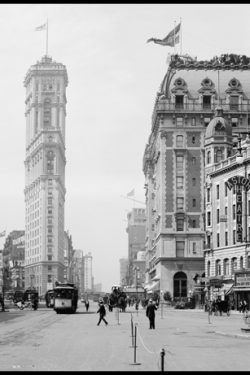In conjunction with its exhibition TIMES SQUARE, 1984, The Skyscraper Museum presents a series of programs that reunite key actors in the transformation of Times Square over the past three decades. Each evening focuses on a set of issues and questions that ask the original authors, including government officials, planners, urban designers, developers, architects, preservationists, and activists, what really happened in the Eighties, and how do they assess their actions today?
In the early 1980s, preservationists battled to save historic theaters in two areas called “Times Square.” On 42nd Street between Seventh and Eighth Avenue, the urban renewal plans of the NYS Urban Development Corporation (UDC) sought to rescue derelict theaters and return the blighted block, plagued with high crime rates and pornography, to more populist entertainments.
In the northern section of Times Square along the spine of Broadway, allied forces of actors and producers, including Joseph Papp, preservationists, architects, and civic groups fought on several fronts against the demolition of historic theaters still in active use. Although the beloved Helen Hayes and Morosco were ultimately razed in 1982 to make way for the Portman Marriott Marquis Hotel, the political action of these groups united to give impetus to the eventual landmark designation of 28 Broadway theaters.
Further, the issue of a broad, but subjective preservation value of a “sense of place” became a special focus for many architects and activists dedicated to saving Times Square. Many argued that new high-rise development encouraged by zoning would obliterate the “bowl of light”- the open sky above the bright electric advertising signs in the “bow-tie” area of Times Square from 42nd to 46th Street. Their protests created a constituency that moved the Department of City Planning to adopt revised zoning amendments that required setbacks from the street and mandated large areas of illuminated signs to be incorporated on new skyscrapers.
Thirty years ago, preservationists acted effectively to protect the physical fabric and the essential character of at least two Times Squares. Were they successful? A panel of key players in the drama of the preservation of Times Square will reflect on the legacy and evolution of today’s Times Square.
Speakers
Kent L. Barwick was president of the Municipal Art Society from 1983 to 1995, and again from 1999 through 2009. From 1978 to 1983, he was Chairman of the New York City Landmarks Preservation Commission. Currently, he is chairman of the State Council on Waterways.
Laurie Beckelman was the Executive Director of the New York Landmarks Conservancy in the 1980s before serving as Chair of the New York City Landmarks Preservation Commission from 1990 to 1994. In 1995, she became the Executive Director of The Joseph Papp Public Theater. Laurie is one of the founding partners at the strategic advisory firm Beckelman + Capalino that focuses on working with arts, cultural, educational, and historic preservation organizations.
Cora Cahan has served, since 1990, as the President of The New 42nd Street, a non-profit formed by the City and State to address the future of seven theaters on the block between Broadway and Eighth Avenue. Before her work at The New 42nd Street, Cora founded the Feld Ballet, transformed the Elgin Cinema into the Joyce Theater, and developed the Lawrence A. Wien Center for Dance.
Jack Goldstein was a founding member and then Executive Director of Save the Theaters, Inc., working on the campaign to prevent the demolition of the Helen Hayes and Morosco Theaters, and then spearheading the successful effort to Landmark Broadway’s remaining theaters. As the Executive Director of the Theatre Development Fund, he conceived and oversaw the design competition for the new TKTS Booth in Times Square. He is a longtime official at Actors’ Equity and is writing a book on the 1980s battles to save Broadway’s historic theaters.
Lee Harris Pomeroy founded his architecture firm in 1964. His involvement with Broadway Theater preservation and planning began in the 1980s as a member of midtown Community Board 5, when he created an alternative build over scheme for the Portman Hotel, which led to a Theater District preservation plan and the landmarking of other historic Times Square theaters.
